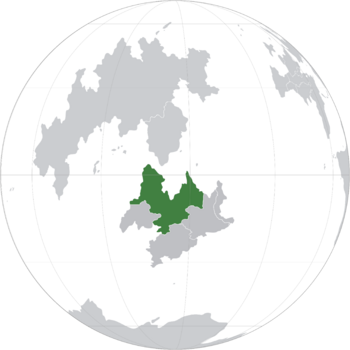Amandine
This article is incomplete because it is pending further input from participants, or it is a work-in-progress by one author. Please comment on this article's talk page to share your input, comments and questions. Note: To contribute to this article, you may need to seek help from the author(s) of this page. |
Federal Republic of Amandine République Fédérale d'Amandine | |
|---|---|
 Location of Amandine | |
| Capital | Colette |
| Largest city | St. Laurine |
| Official languages | Standard Vervillian |
| Recognised national languages | Blaykish |
| Demonym(s) | Amand |
| Government | Federal semi-presidential constitutional republic |
• President | Simone Lachance |
• Prime Minister | César Perrault |
| Legislature | Congress |
| Senate | |
| National Assembly | |
| Independence from Blayk | |
• Flavien Revolution | 30 August 1796 |
• Declaration | 12 May 1802 |
• Treaty of Priscille | 2 November 1807 |
• Treaty of Anne-Marie | 26 May 1836 |
| Area | |
• Total | 3,318,987 km2 (1,281,468 sq mi) (1st) |
| Population | |
• 2020 census | 97,810,727 |
• Density | 29.5/km2 (76.4/sq mi) |
| GDP (PPP) | 2020 estimate |
• Total | $4.150 trillion (1st) |
• Per capita | $42,429 |
| GDP (nominal) | 2020 estimate |
• Total | $2.200 trillion (3rd) |
• Per capita | $22,495 |
| Gini (2020) | medium |
| HDI (2020) | very high |
| Currency | Amand Federal Dollar (AFD) |
| Date format | dd-mm-yyyy |
| Driving side | right |
| Calling code | +24 |
| ISO 3166 code | AMD |
| Internet TLD | .ad |
Amandine (Standard Vervillian: Amandine, pronounced /am-an-deen/), officially the Federal Republic of Amandine (Standard Vervillian: République Fédérale d'Amandine) but also known as the Southern Marceaunian Federal Republic, is a sovereign state located in central Marceaunia Minor. It is bordered to the west by the Demontean Ocean, to the north by the Adrienne Sea, and to the northeast by the Hesperian Ocean. Amandine is comprised of fourteen integral regions and a capital territory within 3,318,987 square kilometers, and possesses a population of 97.8 million. The legislative and administrative capital lies within Colette, which is the nation's third largest urban centre following the cities of St. Laurine and Anne-Marie. Other major cities include Aurèle, Nouvelle Valden, Clément, Colombe, and Nouvelle Marbonne.
Amandine was originally inhabited by numerous indigenous nations since the fourth millennium BCE, prior to Auressian exploration in the 1500s. In 1510, the Imperial Port of Colette was proclaimed for the Kingdom of Vervillia by famed explorer Jean-Baptiste Amand II. While the territory was staunchly Vervillian in its identity, the Blaco-Vervillian Union's formation in 1530 sparked a debate over the formal claim to the territory, which lasted until the late 18th century. However, the Blaco-Vervillian Union greatly financially and infrastructurally benefitted the Imperial Port of Colette, which by now had grown its territorial boundaries well past the initial founding site. Between the 17th and 18th centuries, the Imperial Colony of Amandine became a vital trade and economic hub for the Auressian Power, but restrictive mercantilist policies and general sentiments of neglect progressively corroded the previously strong relationship between the territory and the motherland. Already feeling forgotten by the Union, Amandine was formally gifted to the Blaykish Monarchy as a result of the War of Tyrnican Succession (1785) without any local representation in the matter; the Blaco-Vervillian Union's dissolution from the war entirely severed Amandine's governmental connection to Vervillia, worsening the situation even further against the Blaykish Monarchy.
Independence was violently achieved in 1807, with the Republic of Amandine, a confederal representative republic, taking control of the territory and beyond. In 1819, the Confederation of Southern Marceaunia replaced the Republic's government, eventually leading to the First Continental War. During the conflict, the Constitution of 1835 was ratified, establishing the Federal Republic of Amandine. Since then, the country has maintained the same governmental structure as a semi-presidential democratic republic. While Amandine was intertwined in intercontinental affairs for the majority of its history, the nation became an global power from the Great War in 1908 onwards.
Amandine is a federal semi-presidential constitutional republic. It is a founding member of the Assembly of Marceaunian States (AMS) and is involved in numerous bilateral economic and diplomatic agreements with foreign governments around the world. Amandine exerts its spheres of influence around the continent of Marceaunia Minor, as well as the island nations and territories surrounding the region.

